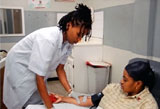Building Capacity for Global Blood Safety
In recognition of World AIDS Day, the progress made by 14
CDC-supported African and Caribbean nations toward delivering an adequate supply
of safe blood was highlighted in the November 28th, 2008 CDC Morbidity and
Mortality Weekly Report.
Through the President’s Emergency Plan for AIDS Relief (PEPFAR), CDC works in
partnership with countries to strengthen laboratory capacity, epidemiology,
surveillance, public health evaluation, workforce capacity, and prevention
initiatives—essential components for strong sustainable public health systems.
 A key part of CDC’s health systems strengthening activities has been five
years of support to improve national blood transfusion services in 14 countries
in Africa and the Caribbean (Botswana, Cote d’Ivoire, Ethiopia, Guyana, Haiti,
Kenya, Mozambique, Namibia, Nigeria, Rwanda, South Africa, Tanzania, Uganda, and
Zambia). This support has included needs assessments, strategic planning,
development of guidelines and training materials, and assistance for procuring
vitally needed commodities.
A key part of CDC’s health systems strengthening activities has been five
years of support to improve national blood transfusion services in 14 countries
in Africa and the Caribbean (Botswana, Cote d’Ivoire, Ethiopia, Guyana, Haiti,
Kenya, Mozambique, Namibia, Nigeria, Rwanda, South Africa, Tanzania, Uganda, and
Zambia). This support has included needs assessments, strategic planning,
development of guidelines and training materials, and assistance for procuring
vitally needed commodities.
Over the past five years, these 14 countries have substantially increased total blood collections from low risk, voluntary, non-remunerated donors; strengthened laboratory capacity to ensure that all collected units are screened for HIV and other transfusion-transmissible infections; and seen a decrease in the prevalence of HIV-infected units. In Kenya, the National Blood Transfusion Service was only providing 20% of blood needed in 2003. Since then, there has been a six-fold increase. Today over 140 of the 181 Kenyan hospitals that transfuse blood get 80% of their blood supply from the national blood service. In Haiti, only 5% of blood came from voluntary donors in 2004. As a result of blood safety initiatives, in 2007, 64% of Haiti’s blood came from low risk, voluntary, non-remunerated donors.
- To read the MMWR article, visit http://www.cdc.gov/mmwr/preview/mmwrhtml/mm5747a2.htm.
- For more information about World AIDS Day, visit www.cdc.gov/features/worldaidsday.
Last reviewed: December 16, 2008
Content Source:
Global AIDS Program (GAP)
National Center for HIV/AIDS, Viral Hepatitis, STD, and TB Prevention
